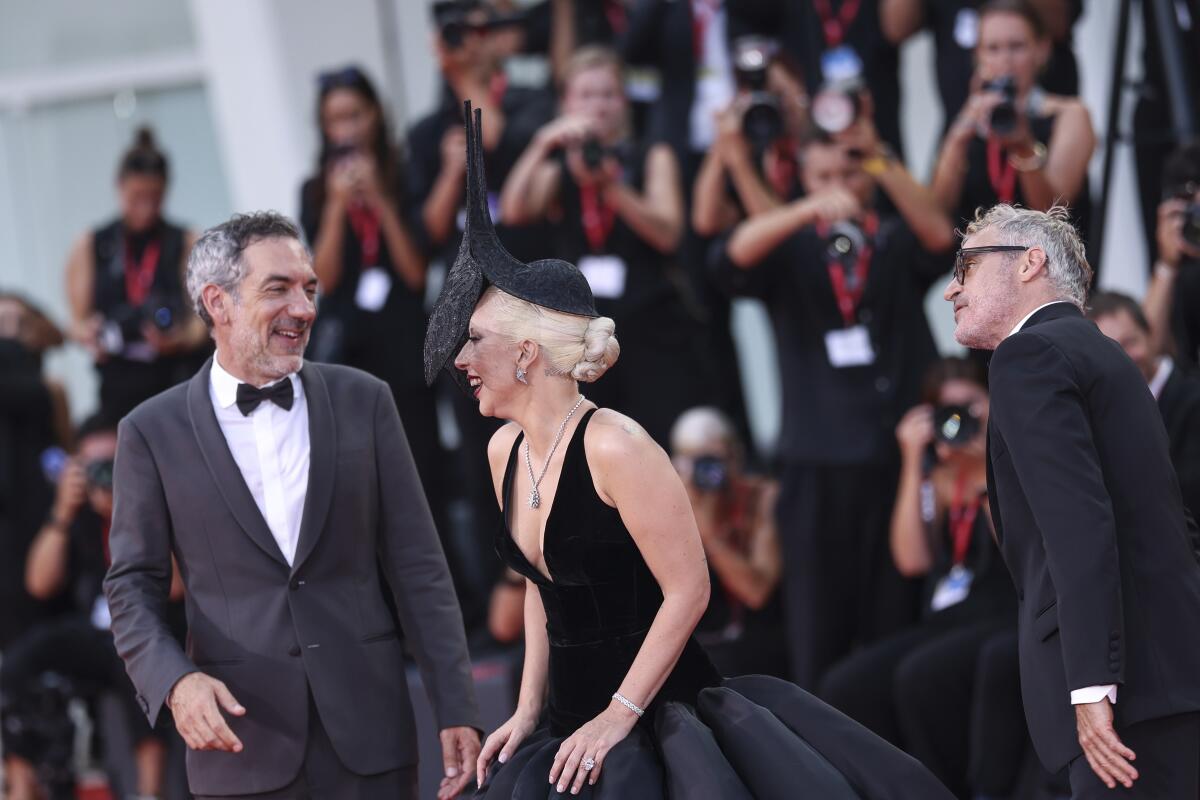Let’s stop pretending that standing ovations at film festivals are newsworthy

- Share via
When “Joker: Folie à Deux” premiered at the Venice Film Festival on Wednesday, the audience erupted into a standing ovation that lasted 11 minutes, according to Variety. The Hollywood Reporter clocked the applause at 10.5 minutes, while Deadline’s timer recorded 12.5 minutes.
Whatever the exact length, star Joaquin Phoenix didn’t stay to the end of the audience’s cheers — the actor was spotted exiting the Sala Grande theater after nine minutes of clapping.
Ten to 12 minutes is an impressive amount of time to spend standing and clapping after watching a movie. To compare, a regular episode of “Bluey” generally runs eight or nine minutes (including the opening theme and credits), while top Olympians can run a 5k in about 13 minutes.
But the length of a standing ovation doesn’t really have any correlation to a film’s quality. Early reviews for “Folie à Deux” have been mixed, with some critics hailing Todd Phillips’ “Joker” sequel as “brilliant” and “impressively odd” and others calling it “frustrating” and “underwhelming.”
Still, reporting the length of the standing ovation after a screening has become a routine part of film festival coverage, especially for Hollywood trades. On Monday, Pedro Almodóvar’s first English-language feature, “The Room Next Door,” made headlines for applause that lasted 17 minutes (or 18 minutes and 36 seconds, depending on who’s counting) at its Venice premiere. This topped the 12-or-13-minute ovation clocked by Brady Corbet’s epic “The Brutalist” just the day before and is reportedly the longest in Venice Film Festival history.
After spending a Labor Day weekend in the Colorado Rockies watching movies, we leave Telluride with several high points: bold documentaries and daring narratives.
Some outlets even keep an ongoing tally of the length of standing Os at film festivals. This tongue-in-cheek coverage is fine as long as it’s understood that it’s often an arbitrary way to quantify a film and not a yardstick for success. (And even The Times includes details about standing ovation length in its coverage.) But we shouldn’t pretend that the length of every standing ovation is newsworthy or treat it as any sort of meaningful metric on its own — especially since the time clocked sometimes varies by publication.
It’s an unfortunate cycle: As more articles focus on the length of standing ovations as the buzzy angle in festival coverage, the more it becomes perceived as an important data point. And the more perceived interest there is around standing ovation length, the more outlets will publish stories about it to try to capitalize on web traffic. (Not to mention, the more film festival attendees become aware that their response is being observed, the more it could affect how long they are willing to cheer for the filmmakers and performers whose work they admire.)
Audience members expressing their appreciation for a piece of art with enthusiastic applause is not a new phenomenon, even at film festivals. Among the major events, the Cannes Film Festival is famous for its extended standing ovations, as well as its vocal booing.
Guillermo del Toro’s “Pan’s Labyrinth” earning a 22-minute standing ovation at its 2006 Cannes premiere is often cited when discussing impressive receptions at film festivals. The 20-minute applause for Michael Moore’s “Fahrenheit 9/11” at Cannes in 2004 is another (the documentary went on to win the Palme d’Or). And while both films were also critically and commercially successful, that can’t be said for every movie that earned 10-minute-plus cheers.
Ovations at Venice have not always been as extensive. The 2019 premiere of the Golden Lion-winning “Joker,” for instance, earned eight minutes of applause. The film, an origin story and character study of one of the most famous comic book villains, received mixed reviews from critics for its depiction of violence and masculinity but still went on to gross more than $1 billion worldwide. Phoenix also won an Oscar for his performance.
Hillary Clinton, James Carville, Jack Smith and other political figures descended on the Telluride Film Festival this year, lending D.C. star wattage to Q&As.
Last year’s Golden Lion winner, Yorgos Lanthimos’ “Poor Things,” earned a 10-minute standing O (or eight minutes, according to Variety). The black comedy was ultimately well received by critics and general audiences alike, grossing $117.6 million worldwide and receiving plenty of awards attention. Among its accolades was an Oscar for its star Emma Stone. But the film stirred controversy for its graphic sex scenes; the protagonist is a woman resurrected with the brain of a child.
Then there are instances like the 2022 debut of “Blonde.” The highly divisive film about a fictionalized Marilyn Monroe from director Andrew Dominik reportedly earned a 14-minute standing ovation but has already been mostly forgotten.
Applause are great. We should cheer on the creators that make the art that moves us. We should even applaud those who make a valiant effort — especially if they’re in the room with us — because creating art is hard.
But movies are more than a collection of stats like the length of a standing ovation or box office haul — discussions generated by “Joker” and “Poor Things” can’t be reduced to their numbers. Our conversations about these giant celebrations of movies known as film festivals should reflect that too.
More to Read
Only good movies
Get the Indie Focus newsletter, Mark Olsen's weekly guide to the world of cinema.
You may occasionally receive promotional content from the Los Angeles Times.













